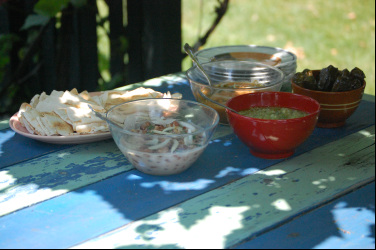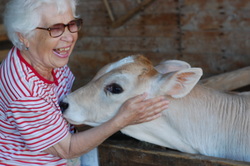 My recent trip to New Jersey was highlighted by a discussion about extreme diets. At first, I did not want to get in the middle, but my friend sent to me an interview with Lierre Keith, the author of “The Vegetarian Myth” who became an omnivore after over 20 years on a vegan diet. After listening to this interview I felt this would be the right time for me to chime in. First of all, either extreme (eating a lot of meat or being completely vegan) is unhealthy. Most people who follow extreme diets tend to do this for some bizarre reason usually related to a belief or a negative experience in life, none of which have to do with the actual physiology of digestion and absorption. Lierre Keith seems to fall into this category. I have not read the book, but from her interview I conclude that she does not have a solid grip of science (specifically biochemistry). With this little knowledge she is attempting to explain biological processes. For example, she claims that our brain cannot be fed a vegetarian diet because this diet is 'full of sugar'. This is simply not true! The only nutrient our brain CAN use is glucose (aka carbohydrate), so eating carbohydrate (CHO) as is would be the fastest way to feed the brain. This could be a donut (simple carbohydrate) or a piece of whole wheat bread, a vegetable, or a fruit (complex carbohydrate). Unfortunately, as good as they taste simple carbohydrates are considered 'empty calories', meaning there is no nutrition value in them (no vitamins), but there is no question they will be good for your brain. Other macronutrients such as proteins and fats will be converted to glucose in the liver. However, the process of absorption will take longer than carbohydrates. The liver is our major organ doing practically all dirty work such as detox (drugs and alcohol breakdown), de-aminating proteins (amino acids are very toxic and have to be diluted with water, and eliminated in urine), and breaking down long- and short- chains of fatty acids, so they can be converted into glucose. This glucose will be then used by the brain, muscles, or stored in adipose tissue for future use. YES, our survival mechanism is amazing and we can live at least 3 months on our fat and muscle storage (eventually our body will start breaking down muscle if fat is not available) as long as we have enough water. Another claim Ms. Keith is stating in her interview is that vegetarian diets do not have enough vitamin D, A, and micronutrients such as zinc and Co-Q10. Well, this is only partially true. Our body produces enough vitamin D (via a series of chemical reactions in the skin) as long as we are exposed to the sun light for at least 15 min a day. There is a reason why Northern countries have concerns with rickets. Many vegetables and fruits contain plenty of vitamin A. Among them are squashes, green leafy vegetables, carrots, and cantaloupes. Many micronutrients such as zinc and Co-Q10 could be taken as supplements, not to mention that most foods in vegetarian diets are now fortified with Thiamin, Riboflavin and B-group vitamins. The Academy of Nutrition and Dietetics consider vegetarian diets healthy as long as they are not restricted in calories (see attached). The only concern may be with calcium intake. Some green vegetables like spinach can be a good source of calcium (Ca), but the absorption of Ca is limited to as little as 5% by the oxalic acid naturally existing in spinach. Unfortunately, the populations most affected by calcium deficiency are young vegan females and female athletes. Their growing bones require a lot of calcium which could be obtained from dairy products. The deficiency of calcium during growth cycle could lead to early osteoporosis (as early as at the age of 30). For example, female athletes are known to present with amenorrhea ending with osteopososis (aka ‘female athlete triad’). It is not my place trying to convince parents how they should be feeding their children, but I believe that using knowledge and evidence-based research we could make right choices. After all, we all want our children to be healthy. I am not a vegetarian, but enjoy many vegetarian dishes. Our life is all about balance and moderation, any extreme could lead to dangerous outcomes. Speaking about balance in diet, here is a healthy breakdown: our daily consumption should consist of 60% carbohydrates, 15% protein, and 25% of fats (preferably long-chain fatty acids found in olive oil, canola oil, etc.). This is, of course, for healthy adults. Sick people would need to consume more protein for recovery and more Omega-3 fatty acids helping to reduce inflammation.
0 Comments
 The vegetarian diet is one of the most common diets among yogis. This tendency is partially derived from the concept of Satvic foods which consists of fresh fruits, vegetables, seeds, nuts, tofu, beans, dairy products, and honey, as well as fruit or vegetables juices. However, there are many other reasons for choosing a vegetarian diet; for example, health considerations, environmental and economic factors. Some people may have concerns about animal welfare, while others reflect on world hunger and religious beliefs. Whatever the reason, 7.3 million adults in the U.S. now consider themselves vegetarians. A classic definition of a vegetarian is someone who does not eat meat (including fowl) or seafood, or products containing these foods, but is this really that simple? There are a wide variety of vegetarian and semi-vegetarian diets including those who consume dairy products and eggs (lacto-ovo) along with the standard base of grains, vegetables, fruits, legumes, seeds, and nuts. The lacto-vegetarians exclude eggs, and vegans are sometimes called ‘total vegetarians’ excluding from their diet fish, meat, poultry, dairy, egg, as well as any other animal products. What about those who only eat fish (pesceterians), or those who only eat vegetables, grains and legumes (macrobiotic diet)? According to the Academy of Nutrition and Dietetics (formerly known as the American Dietetic Association), these types of diets are classified as ‘near-vegetarian’ diets. As my husband commented wisely: “Those are the folks who eat hamburger near an Indian restaurant”. Seriously, a raw food diet can be vegetarian, consisting of mainly uncooked and unprocessed foods, but it can also include unpasteurized dairy products, raw meat and raw fish. (I will comment on the dangers of such eating patterns in my future blogs). Fruitarian diets are considered vegan and based primarily on fruits, nuts and seeds. They can also include vegetables classified botanically as fruit, such as tomatoes and avocadoes. Of course, there are always folks who will eat meat and fish occasionally, but describe themselves as vegetarians. This particular case will fit under category of semi-vegetarians. Although not a vegetarian myself, I love making vegetarian dishes. They are always fresh, and often include many ingredients and spices. The good news is that the Academy of Nutrition and Dietetics recognizes those diets as healthy, and when well-planned (nutrient-wise), they may have a number of health advantages. For example, vegetarian diets were associated with lower cholesterol, lower risk of heart disease, lower blood pressure and hypertension, as well as lower body mass index (BMI) and lower risk of type 2 diabetes. So, keep munching and stay tuned! The next blog will be dedicated to macro- and micro-nutrients in vegetarian diets.  Did you know that Yoga was not always taught to women? In male dominated India women faced many rules and restrictions related to their menstrual cycle - in some cases they were declared ‘untouchable’ for the duration of this period. Fortunately, modern knowledge has changed this situation, and now more women-practitioners (termed ‘yogini’) are entering the spiritual and physical world of Yoga. According to Chandra Cuffaro, a yoga teacher from the Krigshnamacharya Health and Yoga Foundation in Rome as well as a long-time practitioner, women go through seven parinamas (transformations) throughout their lives. Yoga helps to cope with these transformations, and offers much needed support during these times. The first parinama occurs during puberty when a girl’s body changes and takes on a more rounded shape. Often, especially in modern times, these changes can be regarded as negative and undesirable. Yoga helps young girls understand their bodies and the changes that come with physical maturation; they learn to appreciate their new form and properly maintain it through exercise and a balanced diet (not starvation). The second parinama happens when the young woman marries and has to adjust to a new life with another person. Marriage means ‘sharing’ and sharing means adjusting. Everything in her life is going to be different now, and Yoga, especially the spiritual, meditative part will offer a great deal of mental help. The third parinama is pregnancy. A woman’s physiological and emotional levels are suddenly and simultaneously exploding; she has no idea how to handle this situation. Yoga provides a phenomenal balancing power that gives stability and calm, and allows the woman to enjoy this precious moment of binding with another being. The fourth parinama extends throughout the entire period of pregnancy – it encompasses a major transformational period which alters the woman biologically and mentally. Again, through regular practice Yoga helps build the most wonderful relationship between the mother and baby. We now arrive at the time of delivery – the fifth parinama. Along with joy there is always fear of pain, problems with delivery, concerns for the child’s health, and much more. These worries could be overwhelming for a woman, and may intensify any upcoming issues if she is not adequately prepared. Regular Yoga practice during pregnancy can increase focus and build proper breathing techniques thereby attenuating any possible negative outcomes. At this point you can probably guess that the sixth parinama is the post-partum time when a woman is adjusting to less sleep, less time for herself, and establishing an amazing connection with the newborn. In many cases a woman must show her husband that his role as a father is very important, that she needs his help. The Yoga practice could be of utmost importance, and gives direction on how to manage this change. A long time will pass between the sixth and the seventh and last parinama. The woman will face many adjustments, but she will be ready through her continuous Yoga practice. Menopause will constitute the last stage in a woman’s transformation cycle. Chandra Cuffaro calls it ‘the phase of serenity’ when results are not as important as the quality of doing; it is the time of peace and wisdom. |
AUTHOR
Mariya Power has a Master's Degree in Nutrition and Food Science from the University of Vermont; has conducted research on effects of cinnamon extract in type II diabetes, and is a passionate yoga enthusiast. Archives
March 2015
Categories
All
|
Web Hosting by IPOWER
 RSS Feed
RSS Feed